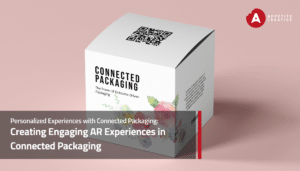
Creating Engaging AR Experiences in Connected Packaging
Augmented Reality (AR) is redefining how brands engage consumers, transforming everyday packaging into dynamic, interactive experiences. With AR technology, connected packaging offers immersive digital experiences that captivate audiences, increase brand awareness, and drive engagement. In this post, we’ll dive into the basics of AR in packaging, design and user experience best practices, and how to measure success through ROI.
AR Technology Basics
AR technology overlays digital content—like images, animations, or videos—onto the physical world through a smartphone or tablet. By scanning a QR code or image, consumers can instantly access AR experiences, turning a simple product interaction into an immersive brand journey. AR works best when it’s simple and accessible; consumers shouldn’t need specialised devices or complex setup to engage with AR-enhanced packaging.
Design Considerations
Creating a captivating AR experience starts with thoughtful design. Here are a few design elements to consider:
- Brand Consistency: The AR experience should seamlessly integrate with your brand’s identity, from colours and fonts to tone and messaging.
- Clear Instructions: Not all consumers are familiar with AR, so make it easy for them to access. Clear, concise instructions on the packaging can ensure more people engage.
- Storytelling: AR works best when it tells a story or offers something unique—whether it’s product education, gamification, or exclusive content.
- Physical-to-Digital Balance: Make sure the AR content doesn’t overshadow the packaging itself but enhances it, providing added value to the consumer’s physical interaction with the product.
User Experience Best Practices
The success of an AR experience lies in how enjoyable and intuitive it is for consumers. Some best practices include:
- Ease of Use: Ensure the AR experience is easy to access with a single scan and loads quickly, without lengthy app downloads.
- Responsive Design: A well-designed AR experience adapts to different devices and screen sizes, offering a smooth, glitch-free interaction.
- Value for the Consumer: Provide meaningful content—such as usage instructions, recipes, or even rewards. AR should add to the user experience rather than just being a novelty.
- Privacy and Permissions: Be transparent about any data you collect and give users control over their experience, enhancing trust and encouraging engagement.
Implementation Costs and ROI
When introducing AR into your packaging, it’s essential to consider costs and how you’ll measure return on investment (ROI).
Implementation Costs: Depending on the complexity, creating AR experiences can range from relatively low-cost to high-end, fully interactive experiences. Factors influencing cost include the level of interactivity, graphics quality, and whether the experience is app-based or web-based (web AR is generally more accessible).
Measuring ROI: To understand the value of your AR packaging, track metrics like:
- Engagement Rates: The percentage of consumers who access the AR experience.
- Time Spent: How long users engage with the AR content, indicating interest levels.
- Conversion Rate: If the experience is tied to a call-to-action, such as signing up for a newsletter or making a purchase.
- Brand Awareness: Social shares and user-generated content that increase brand visibility.
Unleash the Power of AR in Your Packaging
AR in connected packaging offers brands a powerful way to engage audiences and provide value beyond the product itself. By designing user-friendly, memorable experiences, your brand can foster stronger connections, drive sales, and boost consumer loyalty.
Curious to see how AR can transform your packaging? Visit the Appetite Creative website to explore our innovative digital experiences and discover how we’re bringing brands to life with cutting-edge interactive solutions. Let’s make your packaging stand out!
